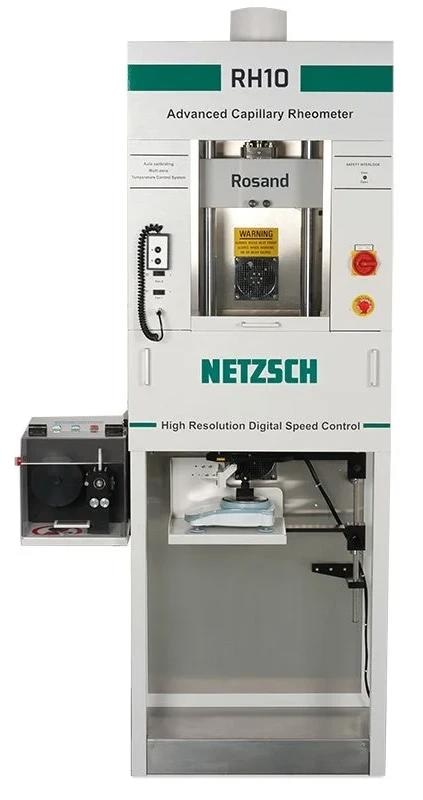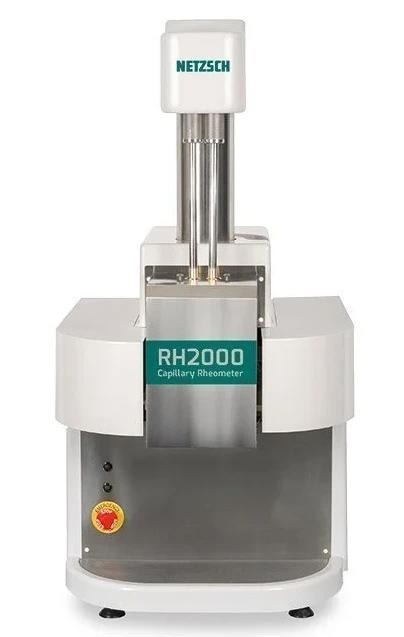The sturdy “H” frame design of the Rosand RH7 and RH10 floor standing capillary rheometers, which are in use in hundreds of research labs worldwide, permits operation under extremely high loading conditions and offers optimal space for a variety of accessory configurations.

Image Credit: NETZSCH- Gerätebau GmbH
Features and Benefits
Research-level Rosand RH7 and RH10 capillary rheometers provide extremely varied measuring capabilities for materials subjected to high shear rate extrusion and high pressure, ranging from foodstuffs to coatings and inks, and polymer melts to ceramics.
- Below the barrel exit, the design accepts optional accessories like melt cutters, die swell measurements, slot die systems, and melt strength (Haul Off)
- Extensive dynamic speed range (up to 400,000:1) and high force range (up to 100 kN) enable test correlation with actual material processing conditions.
- As a standard, twin-bore barrels allow the simultaneous calculation of extensional (elongational) viscosity and absolute shear viscosity measurements.
- Various optional barrel materials and sizes are available to measure aqueous, chemically aggressive, or heat-sensitive samples.
- Many highly accurate tungsten carbide dies are available as standard (Hastelloy is optional) to accommodate various test types and materials.
- Configured with low noise, triple-stage amplifiers for optimal measurement sensitivity at the die entry when using “zero-length” dies (extensional viscosity measurements), easily interchangeable melt-pressure transducers are available to meet all test requirements
- When testing in a dry, inert atmosphere, a nitrogen purge option reduces sample degradation.
- An integrated fume chamber with extraction releases sample gases for operator safety.
- Flowmaster software is user-friendly and offers comprehensive tests and analyses for shear and extensional viscosity. It can also be used to determine wall slip, pVT, melt strength, and melt fracture, in addition to sample stability.
- Proprietary bi-modal speed control algorithms that can be used at high and low speeds
- The sample temperature can be precisely controlled using three separate zone heaters and highly accurate platinum resistance thermometers. Options for cooling coils and high temperatures (up to 500 ºC) are also available.
- Rigid ‘H’ frame design for compliance-free measurements in transient tests such as pVT determination
Key Applications
- Simulation of processes dominated by extensional viscosity, such as film-blowing thermoforming, blow molding, and fiber-spinning
- Rheological characterization of a solution or polymer across a wider range of temperatures and shear rates
- Evaluating a material’s behavior at shear rates that are important to the process, such as those in high-speed coating and printing applications
- Assessing the behavior of extrusion for procedures like hot melt extrusion and injection molding
- Measurement of elasticity and associated characteristics of materials, such as die swell.
- Detecting polymer instabilities such as thermal degradation and melt fracture
Industry Applications
- Polymers
- Coatings
- Ceramics
- Metals
- Pharmaceuticals
- Sealants
- Foods
- Inks
Large Floor Standing Capillary Rheometer - Rosand RH2000

Image Credit: NETZSCH- Gerätebau GmbH
The Rosand RH2000 capillary rheometer from NETZSCH is a small device that meets most capillary rheometry test needs. The rheometer combines numerous complex capabilities common to larger floor-standing versions and can be configured for research measurements and quality control purposes.
Features and Benefits
The Rosand RH2000 benchtop capillary rheometer offers incredibly versatile measurement capabilities and configuration options from polymer melts to pharmaceutical processing and from foodstuffs to inks and coatings.
- Maximum speed (up to 1200 mm/min) and maximum driving force (up to 20 kN) capabilities enable a wide range of shear rates and correlation with various real-world material processing circumstances.
- Single- and twin-bore barrel versions are available for low-cost regular measurement capabilities, as well as dual measurements for simultaneous assessment of absolute extensional (elongational) and shear viscosity.
- The unique swivel head design makes the rheometer barrel conveniently accessible for instrument maintenance and sample loading.
- The rigid single-piece cantilever frame design provides extremely high mechanical strength and rigidity for a compact benchtop item.
- The special swivel head design allows easy access to the rheometer barrel for sample loading and instrument maintenance.
- A range of different barrel materials and sizes are offered to facilitate the measurement of samples that are aqueous, chemically aggressive, or heat sensitive.
- The sample temperature can be adjusted using three independent zone heaters and extremely accurate platinum resistance thermometers. Further options exist for high temperatures (up to 500 °C) and cooling coils.
- Triple-stage amplifiers in melt pressure transducers' design minimize noise and allow for easy replacement, maximizing measurement sensitivity at the die entrance.
- Proprietary bi-modal speed control algorithms can be applied at both high and low speeds.
- To reduce sample deterioration, there is a purge nitrogen option
- Attachments for measuring die swell to assess elastic samples
- Flowmaster software is easy to use and provides a wide range of shear and extensional viscosity tests and analyses. It also allows for the determination of melt fracture, wall slip, and sample stability
Key Applications
- The simulation of processes that are dominated by extensional viscosity, such as blow molding, film blowing, thermoforming, and fiber spinning
- Recognizing instabilities in polymers, such as melt fracture and thermal deterioration
- Assessing the behavior of extrusion in techniques such as injection molding and hot melt extrusion
- Characterizing the rheology of suspension or polymer over a broad range of temperatures and shear rates